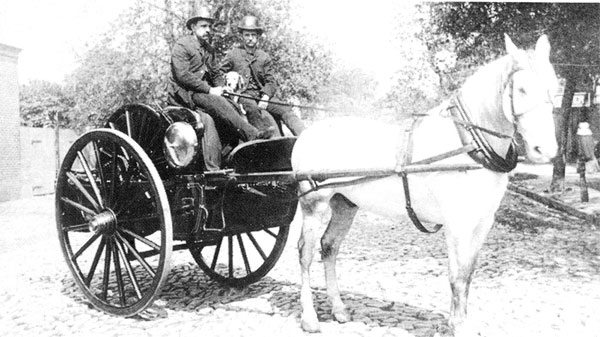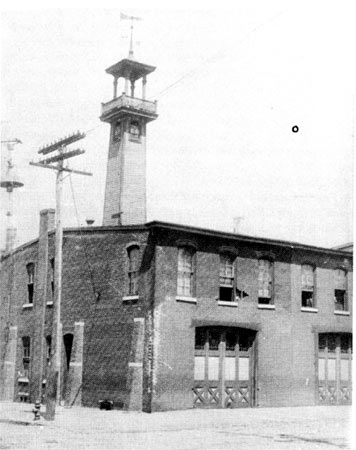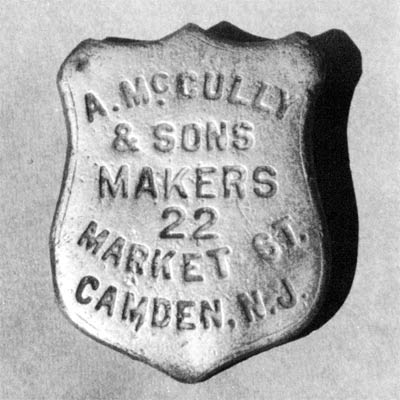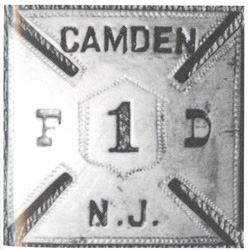|
Named
after the late president, who had died the previous
spring, William H.H.
Clark was born on November 19, 1841 to Samuel Clark and
his wife, the
former Ann Bennis. He was the seventh of eleven children
born to the
Clarks. William H.H. Clark had come to Camden by the
time the 1860
Census was being enumerated. He was working as an
express driver and
boarding with Isaac Whitecar and family in Camden's
South Ward.
When
war broke out between the North and South, William H.H.
Clark answered
his nation's call. He enlisted as a private in the 4th
New Jersey
Infantry Militia Regiment (Also known as the Twentieth
New Jersey
Infantry) on April 27,1861, and was subsequently
assigned to Company G.
He served alongside his brother, Corporal James M. Lane.
The Fourth
Regiment Militia was commanded by Colonel Matthew
Miller, Jr.; his
officers were Lieutenant Colonel Simpson R. Stroud and
Major Robert C.
Johnson. This regiment was mustered into the U. S.
service at
Trenton, April 27, 1861, to serve for three months, and
left the
state for Washington, D. C., on May 3, with 37
commissioned
officers and 743 non-commissioned officers and privates,
a total of 777.
On the evening of May 5 it reached the capital, and on
the 9th it was
ordered to go into camp at Meridian hill, where, within
a few days
the entire brigade was encamped, and where, on the 12th,
it was
honored by a visit from the president, who warmly
complimented the
appearance of the troops. On the evening of May 23 it
joined the
2nd and 3d regiments and about midnight took up the line
of march
in silence for the bridge that spanned the Potomac. This
bridge was
crossed at 2 o'clock on the morning of the 24th, the 2nd
was posted
at Roach's spring, and the 3d and 4th about half a
mile beyond on
the Alexandria road. On July 16, a guard was detailed
from the 4th
for a section of the Orange & Alexandria railroad,
which it was important
to hold; one company from the regiment guarded the Long
bridge;
still another was on duty at Arlington mills; and the
remainder of
the regiment, together with the 2nd, was ordered to
proceed to
Alexandria. On July 24, the term of service having
expired, the 4th
returned to New Jersey and was mustered out at Trenton,
July 31, 1861.
The total strength of the regiment was 783, and it lost
by
discharge 6, by promotion 2, by death 2 and by desertion
7,
mustered out, 766
.
Barton Lane was among those mustered out on July 31, 1861 at
Trenton.
Several
men who served with the Fourth New Jersey became members
of the Camden
Fire Department after it was founded in 1869, including
Benjamin
Cavanaugh,
J.
Kelly Brown,
Henry
F.
Surault,
edward
mead,
William
Cox,
James
M. Lane,
William
Gleason,
Theodore
A. Zimmerman,
Charles
G. Zimmerman,
William
C. Lee,
George
B.
Anderson,
Jesse
Chew,
William
W. Mines,
Cornelius
M. Brown,
John
J. Brown,
Benjamin
Connelly, and
G.
Rudolph Tenner. Several other Fourth Infantry
veterans played
significant roles in Camden in the ensuing years.
William
H.H. Clark returned to Camden, but not for long. He
married his wife,
Sarah, around 1862. On August 31, 1864 William H.H.
Clark enlisted in
the United States Navy. He served until July 6, 1865,
then returned to
his wife in Camden, where he apparently became active as
a volunteer
fireman.
On September 2, 1869 City
Council enacted a municipal
ordinance creating a paid fire department. It provided
for the annual
appointment of five Fire Commissioners, one Chief
Marshal (Chief of
Department)
and two Assistant Marshals. The City was also divided
into two fire
districts. The boundary line ran east and west, starting
at Bridge
Avenue and following the tracks of the Camden and Amboy
Railroad to
the city limits. District 1 was south of this line and
District 2 was
north. The commissioners also appointed the firemen who
were
scheduled to work six 24 hour tours per week.
William
Abels, from the
Weccacoe Hose Company No. 2 was appointed Chief Marshal
with William
J. Mines, from the Independence Fire Company No.
3 as Assistant Marshal
for the 1st District, and
William
H. Shearman as the Assistant Marshal
for the 2nd District.
Abels
had served with the volunteer fire
departments of Philadelphia, Mobile, Alabama and Camden
for sixteen
years prior to his appointment as Chief of the paid
force.
On
November 10, 1869 City Council purchased the
Independence Firehouse,
the three-story brick building at 409
Pine
Street, for $4500. The
building was designated to serve as quarters for
Engine
Company 1
and
the 1st District. On October 29, 1869 City Council
authorized
construction of a two-story brick building on the
northwest corner of
Fifth
and
Arch
Streets as
quarters for the 2nd District. On November
25th the Fire Commissioners signed a contract with M.N.
Dubois in the
amount of $3100 to erect this structure. The 2nd District
would share
these quarters with
Engine Company
2 and the
Hook
& Ladder Company
and the facility would also
serve as department headquarters
for the new paid force. The original contract remains
part of the
Camden County Historical Society collection.
|

|
|
Engine
Company 2 with 1869
Silsby Hose Cart. Photo Circa
1890. Note badges
upon derby hats worn by Fire
Fighters.
|
Two
Amoskeag second class, double pump, straight frame steam
engines were
purchased at a cost of $4250 each. Two Silsby two wheel
hose carts,
each of which carried 1000 feet of hose, were another
$550 each and
the hook & ladder, built by Schanz and Brother of
Philadelphia was
$900. Each engine company received a steam engine and
hose cart.
Amoskeag serial #318 went to
Engine
Company 1, and serial #319 to
Engine
Company 2. The Fire Commission also secured the
services of the
Weccacoe and Independence steamers in case of fire prior
to delivery
of the new apparatus. Alfred McCully of Camden made the
harnesses for
the horses. Camden's Twoes & Jones made the
overcoats for the new
firemen and a Mr. Morley, also of Camden, supplied the
caps and belts
which were manufactured by the Migeod Company of
Philadelphia. The new
members were also issued badges.

|
This
is the earliest known photo of fire
headquarters on the northwest
corner of
Fifth
and
Arch
Streets. Originally built in
1869, the
building shows signs of wear some
twenty years later. Note the
weathervane shaped like a fireman's
speaking trumpet atop the tower.
Also, the fire alarm bell is
pictured to the left of the
telegraph
pole above the rooftop. The bell was
removed from the building once
the fire alarm telegraph system was
expanded and in good working
order.
|

|
This
maker's plate once was attached
to a harness made by A. McCully
&
Sons, 22 Market Street, Camden,
New Jersey. This firm provided
the
first harnesses for the paid
fire department in 1869.
|
Badges
worn by the marshals, engineers, stokers and engine
drivers bore the
initial letter of their respective positions and their
district
number. The tillerman and his driver used the number "3"
to
accompany their initial letter. The extra men of the 1st
District
were assigned badges 1-10; 2nd District badges were
numbered 11-20 and
the extra men of the hook & ladder wore numbers
21-30.
Although
the Fire Commission intended to begin operation of the
paid department
on November 20, 1869, the companies did not actually
enter service
until December 7th at 6 P.M. because the new apparatus
and buildings
were not ready. The new apparatus was not tried (tested)
until
December
9th.
The
new members of the paid force
were:
|

|
The
first style of breast badge worn
by members of the career
department
in the City of Camden. 1869.
(Courtesy of the C.C.H.S.
Collection).
|
When
the Census was taken in 1870 William H.H. Clark was
living in Camden's
South Ward with his wife Sarah and two children, Eliza
(or Lydia), 3,
and Joseph, 1. He was working full-time for the Fire
Department. William
H.H. Clark appears to have left the Fire Department when
Chief William
Abels was replaced in 1871.
As
stated above, he was living at
811 Kaighn
Street in 1869. The
1878 City
Directory gives an address for William H.H. Clark of
825 Kaighn
Street,
which was renamed
Dauphin
Street a few years later. By 1879 he had
relocated to 431
Spruce
Street. The 1880 Census shows William H.H. Clark
living at 406
Cherry
Street. There were three children at this time,
Lydia, 14; Virginia
"Jeannie" 4; and Annie, 1. The Clarks moved 937
South
5th Street prior to the compilation of the 1882-1883
Directory. By
the end of 1885 they had moved to 411
Division
Street. William H.H. Clark was working as a teamster
in
Philadelphia. The 1887-1888 and 1888-1889 Directory gives an
address of
820
South
4th
Street. The 1890 Veterans Census and 1900 Federal
Census shows the
Clarks had moved one last time, to 814
South
4th Street. The Census states that Sarah Clark had
given birth to
seven children, three of whom were still living. Only
Jeannie Clark was
living with her parents. On March 17, 1901 William H.H.
Clark passed
away.
William
H.H. Clark was a member of the
Thomas
M.K. Lee Post No. 5 of the Grand Army of the
Republic.
|